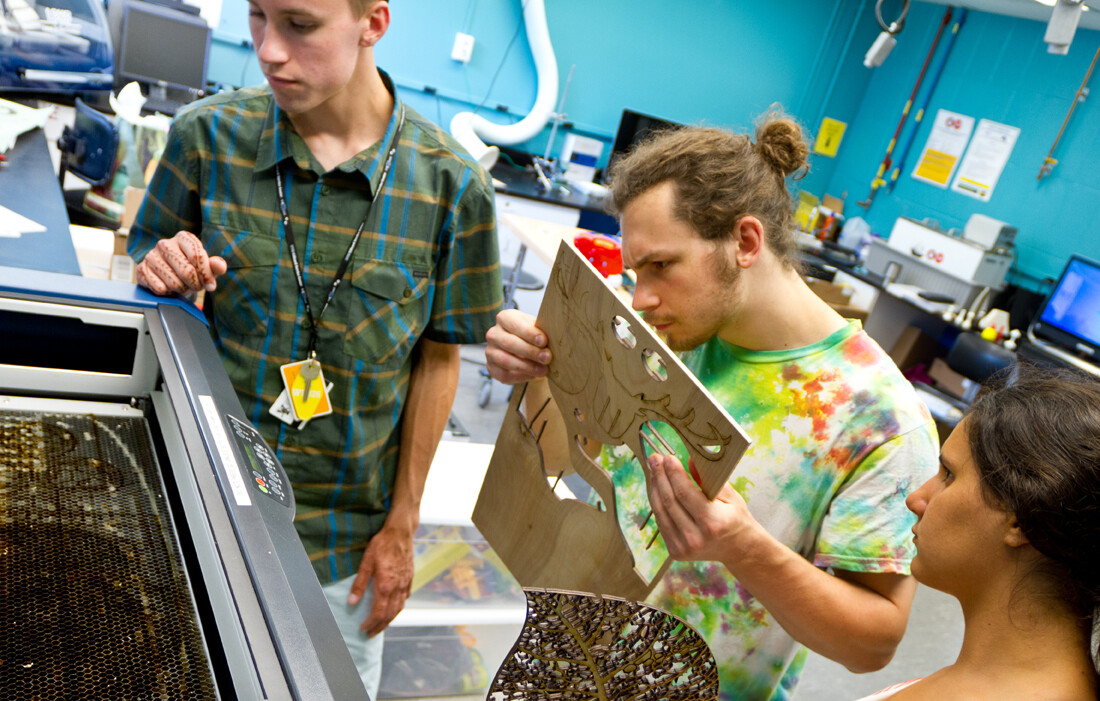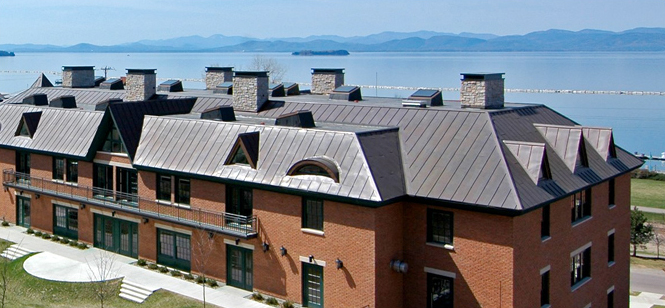By Joshua E. Brown
Rachel Schneck holds up a thin sheet of wood intricately cut into the shape of a leaf. Down the table sits a plastic toy guitar with its electronics ripped open. On one wall, a 3-D printer slowly ejects layers of plastic in the shape of Minnie Mouse, an elephant and a Star Wars clone trooper helmet. At the other end of the room is the tabletop laser-cutter that she programmed to cut out her leaf.
Schneck, age 16, travelled from Chicago to Vermont to work in this room, UVM’s Fabrication Laboratory in the College of Engineering and Mathematical Sciences. She’s taking a UVM pre-college course, “Vermont FabLab Workshop,” instructed by Jenn Karson, MFA, that is introducing her to the increasing number of links between art and technology. “This class really helps me see the connections between the physical and digital worlds,” Schneck says.
And it may be helping her set her path for college and beyond. “I wanted to figure out what I wanted to do for college, but I didn’t have any ideas,” she says. “This has opened new worlds for me. I would never have pulled apart toys, or opened circuits or really thought about engineering if it wasn’t for this course.”
“We’re not just thinking about stuff,” she says. “You know, we’re building stuff.” Sure, they might be “Barbies with LEDs sticking out of their eyes,” as Schneck describes one of the projects, but underneath this slightly creepy/goofy toy hacking project is a serious introduction to a new world where art and engineering converge: “the DIY maker movement” as Karson’s course description puts it.
Jenn Karson holds up Schneck’s wooden leaf again. It looks lovely, but a few of the filigrees look a bit ragged and one or two sections didn’t get cut through fully. She speaks with her student and her teaching assistant, Alex Poniz ’15, a mechanical engineering major. They agree to run the design through the laser cutter again. Getting it right is part of the learning.
Into the Unknown in the Maker Movement
Another student in the course, Griffin Spurr, age 16, traveled from San Francisco to Vermont. He’s never taken a summer course before. He’s carefully connecting a series of wires and a tiny motor to a circuit board connected to a laptop; it’s an arduino kit. “I’m not sure what I’m doing right now,” he says. “I’m not even sure what this is supposed to do.” Then he stops, looks up, and grins. “I have a feeling it’s probably going to spin.”
Going cheerfully into the unknown is part of the learning too. He, Schneck, and the other high schoolers in this UVM Summer Academy course offered by Continuing and Distance Education are being pushed to think about the connections between design, ecology, and creativity — while making handmade electronics, microcontrollers, e-textiles, and other hybrid electronic/art/digital objects. They each are culminating the course with a self-designed project. “I want to make a laptop cooling pad — I have one and it’s terrible,” Griffin says. “I can make mine better.”
After the group portion of this course concludes, they’ll spend two week working on their own to finish these projects. Spurr imagines one that pumps nonconductive mineral oil directly over his computer’s circuits. He’s looking forward to building it.
Joshua E. Brown is a staff writer at University Communications.
This story was originally published on UVM Today.





